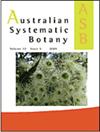Big trees of small baskets: phylogeny of the Australian genus Spyridium (Rhamnaceae: Pomaderreae), focusing on biogeographic patterns and species circumscriptions
IF 1.6
3区 生物学
Q4 EVOLUTIONARY BIOLOGY
引用次数: 2
Abstract
Abstract. Spyridium Fenzl is a genus of ~45 species endemic to south-western and south-eastern Australia. This study provides the most comprehensive phylogenies of Spyridium to date, analysing both entire chloroplast genomes and the nuclear ribosomal array (18S–5.8S–26S). There was substantial incongruence between the chloroplast and nuclear phylogenies, creating phylogenetic uncertainty, but some clear relationships and biogeographic patterns could be established. Analyses support the monophyly of Spyridium, identifying an early east–west split at the base of the nuclear phylogeny and deep divergences of New South Wales and Tasmanian endemic clades. We also found evidence of more recent dispersal events between eastern and western Australia and between Tasmania and the mainland. Eleven taxa were found to be monophyletic in the nrDNA phylogeny and two were clearly polyphyletic (S. eriocephalum Fenzl and S. phylicoides Reissek). Although the polyphyly of S. eriocephalum correlates with the two varieties, suggesting distinct taxa, further research is required on S. phylicoides.小筐型大树:澳大利亚梨属的系统发育,重点研究生物地理格局和种界
摘要芬兹Spyridium Fenzl是澳大利亚西南部和东南部的一个约45种的特有属。这项研究提供了迄今为止Spyridium最全面的系统发育,分析了整个叶绿体基因组和核核糖体阵列(18S–5.8S–26S)。叶绿体和核系统发育之间存在很大的不一致,造成了系统发育的不确定性,但可以建立一些明确的关系和生物地理学模式。分析支持Spyridium的单系性,在新南威尔士州和塔斯马尼亚州特有分支的核系统发育和深度分化的基础上确定了早期的东西分裂。我们还发现了澳大利亚东部和西部以及塔斯马尼亚州和大陆之间最近发生的疏散事件的证据。在nrDNA系统发育中发现11个分类群为单系,2个明显为多系(S.eriochalum Fenzl和S.physicoides Reissek)。尽管毛头S.eriochalum的多聚性与这两个品种相关,表明了不同的分类群,但还需要对S.phylicoides进行进一步的研究。
本文章由计算机程序翻译,如有差异,请以英文原文为准。
求助全文
约1分钟内获得全文
求助全文
来源期刊

Australian Systematic Botany
生物-进化生物学
CiteScore
3.10
自引率
12.50%
发文量
12
审稿时长
>12 weeks
期刊介绍:
Australian Systematic Botany is an international journal devoted to the systematics, taxonomy, and related aspects of biogeography and evolution of all algae, fungi and plants, including fossils. Descriptive taxonomic papers should normally constitute a comprehensive treatment of a group. Short papers on individual species and nomenclatural papers must contain significant new information of broader interest to be considered. The prestigious L.A.S. Johnson Review Series is published. Other review articles will also be considered. All papers are peer reviewed.
Australian Systematic Botany is published with the endorsement of the Commonwealth Scientific and Industrial Research Organisation (CSIRO) and the Australian Academy of Science.
 求助内容:
求助内容: 应助结果提醒方式:
应助结果提醒方式:


